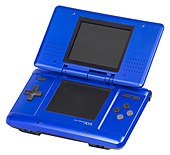Four Different Model of Nintendo Ds
The Nintendo
DS (abbreviated to DS) was a dual-screen handheld game console developed and
released by Nintendo. The device went on sale in North America on
November 21, 2004. The DS, short for "Developers' System" or
"Dual Screen", introduced
distinctive new features to handheld gaming: an LCD screen working in
tandem with a touchscreen, a built-in microphone,
and support for wireless connectivity. Both screens are
encompassed within a clamshell design similar to the Game Boy Advance SP. The Nintendo DS also
features the ability for multiple DS consoles to directly interact with each
other over Wi-Fi within
a short range without the need to connect to an existing wireless network.
Alternatively, they could interact online using the now-discontinued Nintendo Wi-Fi Connection service.
Prior to its
release, the Nintendo DS was marketed as a "third pillar" in
Nintendo's console lineup, meant to complement the Game Boy Advance and
GameCube. However, backward compatibility with Game Boy Advance titles and
strong sales ultimately established the new handheld console as the successor
to the Game Boy series.

The Nintendo DS Lite (abbreviated to DS Lite) is a dual-screen handheld game console developed and
manufactured by Nintendo. It is a slimmer,
brighter, and more lightweight redesign of the original Nintendo
DS. It was announced on January 26, 2006, more than a month
before its initial release in Japan on March 2, 2006 due to overwhelming demand
for the original model. It has been released in Australia, North America,
Europe, New Zealand, Singapore, and defined regions in South America, the
Middle East, and East Asia. As of December 31, 2013, shipments of the DS Lite
have reached 93.86 million units worldwide, according to Nintendo. It was the
final handheld to have backwards compatibility with Game Boy Advance games.

The Nintendo
DSi (abbreviated to DSi) is a
dual-screen handheld game console released
by Nintendo.
The console launched in Japan on November 1, 2008, and worldwide beginning in
April 2009. It is the third iteration of
the Nintendo DS,
and its primary market rival is Sony's PlayStation Portable (PSP).
Development of the DSi began in late 2006, and the handheld was unveiled during
an October 2008 Nintendo conference in Tokyo. Consumer demand convinced Nintendo
to produce a slimmer handheld with larger screens than the DS Lite.
Consequently, Nintendo removed the Game Boy
Advance (GBA) cartridge slot to improve portability without
sacrificing durability.
While the
DSi's design is similar to that of the DS Lite, it features two digital
cameras, supports internal and external content storage, and
connects to an online store called the Nintendo DSi Shop (which was
discontinued in 2017) . Nintendo stated that families often share DS and DS
Lite consoles. Its new functionality was intended to facilitate
personalization, so as to encourage each member of a household to purchase a
DSi. The handheld supports exclusive physical media in addition to DS games
with DSi-specific features and standard DS titles. The only exception to
its backward compatibility are earlier DS
games that required the GBA slot. As of September 30, 2014, Nintendo had sold
41.37 million DSi and DSi XL units combined.
Reviews of
the Nintendo DSi were generally positive; although IGN and bit-tech decried
the console's lack of exclusive software and removal of the GBA cartridge slot,
its added functionality caused many journalists to recommend it to those who
had not purchased a previous DS model. Numerous critics were disappointed with
the limited resolution of DSi's cameras, though others such as Ars Technica and GameSpot agreed
they were adequate for the handheld's display. CNET and PCWorld considered the DSi Shop to be
the most important buying incentive for current DS owners.

The Nintendo
DSi XL (abbreviated to DSi XL) features larger screens,
and a greater overall size, than the original DSi. It is the fourth DS model,
the first to be available as a pure size variation. Iwata said that
cost restraints had, until then, limited the screen size and multiplayer
aspects of portable game consoles, and that the DSi XL offers "an improved
view angle on the screens", which makes it the first "portable system
that can be enjoyed with people surrounding the gamer." He argued that
this introduces a new method of playing portable video games, wherein those
"surrounding the game player can also join in one way or the other to the
gameplay." While the
original DSi was specifically designed for individual use, Iwata suggested that
DSi XL buyers give the console a "steady place on a table in the living
room," so that it might be shared by multiple household members.
The DSi XL
is the longest, widest and heaviest DS model. The console
features two 4.2-inch (110 mm) wide-viewing-angle LCD screens with the
same resolution as the smaller model. It has improved
battery life over the DSi on all brightness settings; for example, batteries
last 13–17 hours at the dimmest setting. The handheld is
outfitted with identical speakers contained in larger speaker
enclosures, enabling them to produce louder sound. The hinges stop
the screen at 120° in addition to the original DSi's position of 155° to allow
easier table-top viewing. The DSi XL is
bundled with two longer styli, one of which is thicker, rounded, and pen-like, and does not fit
inside the unit.















No comments